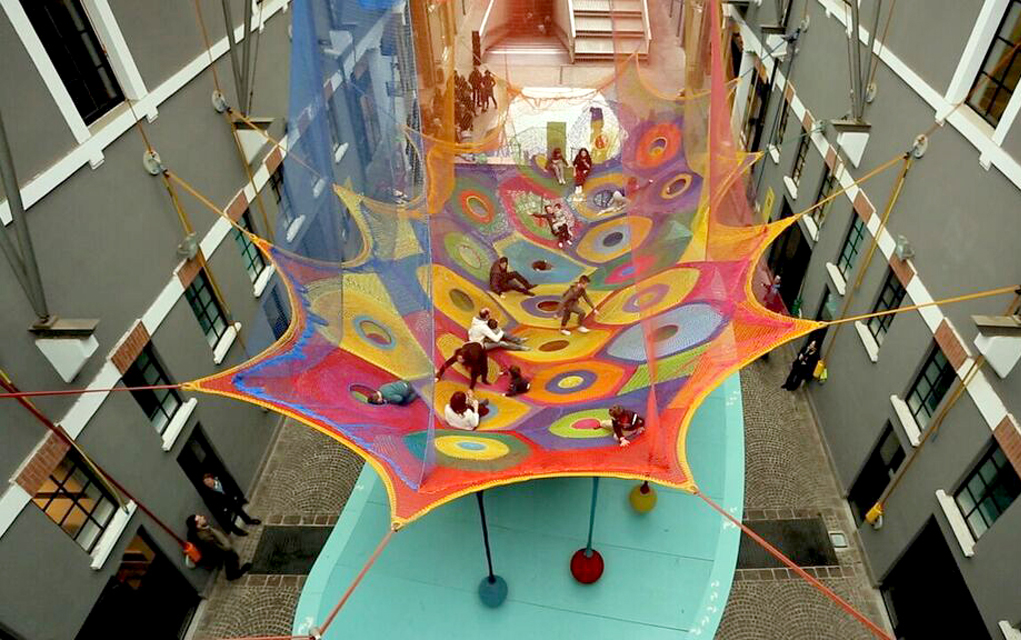
Artist Olek lays on her back holding a staple gun in an empty gallery, putting the final touches on her work. She laments about how she is mistreated and looked down upon for her chosen medium.
“I get a lot of shit from men because I don’t paint,” she says. “It’s not about the technique or what you use, really it’s about what you make. … Being a woman in this world is quite difficult. It’s not because there are less of us. It’s not because we’re less talented. It’s because it’s a really chauvinistic fucking art world.”
When Olek’s piece is done, it hangs in the gallery window: a giant, colorful yarn mural that reads, “Keep Calm & Eat My Cock.”
This is a scene in the new
documentary Yarn from Icelandic director Una Lorenzen, playing at The Dairy Arts Center Aug. 3. Yarn peeks into the world of knitting and crocheting, but it keeps the focus on international artists using yarn as a mode of expression.
The idea for the film started a few years ago after a conversation between co-directors/producers Heather Millard and Thordur Jonsson, not about yarn but about the television show The Great British Bake Off.
“We were talking about how sort of more traditional or former home activities had started to become trendy again like baking,” Millard says. “And we were wondering what would be the new trend.”

interact with her work, serving almost like a playground. Bond/360
They started looking deeper into the world of yarn work and discovered a subset of people pushing the material beyond its more traditional uses. With Yarn, they hope to show the artistic possibilities of the material, from Tilde Björfors, who utilizes it in her contemporary circus performances, to Toshiko Horiuchi, who uses it to create large-scale yarn sculptures.
Along with baking, knitting and crocheting have experienced a resurgence in mainstream culture, thanks to a variety of reasons — looking at you, Pinterest. Millard credits the economic recession and the frenetic modern-day culture as a couple reasons luring people to these hobbies.
“[During the recession] people were starting to grow their own food more and make their own clothes more, and I think that plays into it,” she says. “The state of society today is longing for something a bit more meditative and calming, and knitting and crocheting have been looked at as being therapeutic in that respect.”

But it goes far beyond that for the artists in the documentary. They use yarn to make political statements and to challenge gender normatives, among other reasons. The film deals largely with feminism, even though the filmmakers didn’t set out to make a film with that purpose.
“[Feminism] comes in early in the film and genuinely early when coming in with the artists,” Millard says. “It was something they feel strongly about, and something they’ve struggled with at times. It also led us into the journey of the film.”
“In the back of our minds, we know about these issues,” Lorenzen adds. “I thought it was awesome. We saw this thread building up and we embraced it.”
In the film, yarn bomber Tinna celebrates the art form and its legacy for women.
“Not many areas initially developed by women were first for artistic expression,”she says in the film, as a montage of images of women using yarn through time and across cultures plays. “It is amazing how many women know how to knit and how to crochet and do it as art.”
Tinna continues to talk about how, because knitting and crocheting are seen as a woman’s craft, they’re somehow lower ranked. She also bemoans the double standard she faces using the medium.
“Everyone seems to get so excited when men do it; they jump around and wet themselves with excitement,” she says. “But when a woman knits, and might even do a better job, everyone just considers it to be completely normal.”

As someone might take a can of spray paint to the side of a building, Tinna instead uses yarn, hanging her creations on walls or from telephone poles. She capitalizes on yarn’s feminine quality, and exploits it in her work, calling the practice powerful and beautiful.
“Wool graffiti means to take handicrafts, women’s art and practical art from inside your home and take it out onto the streets of the city,” she says.
“Cities often have masculine energy, sharp corners, everything is gray. Then you are obviously taking some female energy out into the streets of the city. Feminine energy is rosy, soft warm and colorful. It’s fun to see how these two contrast and play together.”
As with other art documentaries, Yarn encourages the viewer to use their own voice. It even inspired Millard to pick up a pair of needles herself. Be it for a scarf or a political statement, yarn serves as a not-so-new tool for expression — and it comes in a variety colors.
On the Bill: Yarn. 7 p.m. Wednesday, Aug. 3, Dairy Arts Center, Boedecker Theater, 2590 Walnut St., Boulder, 303-440-7826.














